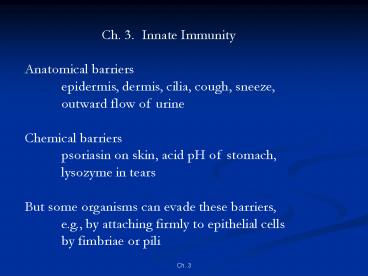Ch. 3. Innate Immunity - PowerPoint PPT Presentation
1 / 36
Title:
Ch. 3. Innate Immunity
Description:
Ch. 3. Ch. 3. Innate Immunity. Anatomical barriers. epidermis, dermis, cilia, cough, sneeze, ... psoriasin on skin, acid pH of stomach, lysozyme in tears ... – PowerPoint PPT presentation
Number of Views:92
Avg rating:3.0/5.0
Title: Ch. 3. Innate Immunity
1
Ch. 3. Innate Immunity Anatomical
barriers epidermis, dermis, cilia, cough,
sneeze, outward flow of urine Chemical
barriers psoriasin on skin, acid pH of stomach,
lysozyme in tears But some organisms can evade
these barriers, e.g., by attaching firmly to
epithelial cells by fimbriae or pili
2
Vertebrates - Two Systems of Immunity 1.
Innate immunity (early in infection) physical,
chemical, cellular barriers 2. Adaptive
immunity (or acquired immunity) - specific
response by B and T lymphocytes memory future
exposures quicker and more vigorous sensors
specific antibodies (Abs) and T cell
receptors (TCRs)
3
p. 53
4
p. 54
5
(No Transcript)
6
Connections Between Innate and Adaptive
Immunity Invaders must be sensed and
destroyed Invaders are recognized by soluble or
membrane-bound molecules These molecules
recognize broad structural motifs that are in
germs, but not in self
7
PRRs and PAMPs
PRRs Pattern Recognition Receptors PAMPs
Pathogen-Associated Molecular Patterns -
combinations of sugars, certain proteins, some
lipid-bearing molecules, and some nucleic acid
motifs - found only on microbes, never on self
8
In contrast, Abs and TCRs of adaptive
immunity recognize finer details of molecular
structure Summary PRRs recognize broad,
essential motifs, present on many groups of
microbes Abs and T-cells recognize fine
differences among different microbes
9
- Examples of soluble mediators of innate immunity
- Mannose-binding lectin (MBL)
- C-reactive protein (CRP)
- When these bind to microbes with PAMPs they
- recognize, the complement system may be
- activated to opsonize microbes or lyse them
10
p. 58
11
p. 58
12
Dendritic cell and macrophages have Toll-like
receptors (TLRs) which detect microbial
products 11 discovered in humans, 12 in
mice When TLR combines with microbe,
macrophage -has increased phagocytic
activity -makes toxic chemicals -makes
cytokines, like IL-1, IL-6, TNF-alpha -thus
inflammatory response is induced
13
p. 58
14
Immature dendritic cells internalize antigen,
process it, mature, migrate to lymph node, and
present processed Ag to T cells for adaptive
immune response. Dendritic cells also secrete a
variety of cytokines that promote inflammation.
15
p. 56
16
Inflammation Can be acute or chronic Acute
redness, heat, swelling (edema),
pain Chemoattractants cause extravasation of
leukocytes (white blood cells) examples are
- chemokines (subclass of cytokines)
- C3a, C5a (from complement) -
N-formyl peptides (from microbes)
17
p. 60
18
(No Transcript)
19
(No Transcript)
20
Soluble Molecules and Membrane-associated
Receptors Antimicrobial peptides contribute to
the defense against bacteria and
fungi Proteins of the acute phase response
contribute to innate immunity Innate immunity
uses a variety of receptors to detect infection
(e.g., MBL, CRP, LBP, NOD)
21
p. 61
22
(No Transcript)
23
Toll-like Receptors (TLRs) Membrane-spann
ing proteins that share a common structural
element in their extracellular region (24-29
aas, xLxxLxLxx, called leucine-rich repeats,
LRRs) Intracellular domain is called the TIR
domain Complete set of TLRs can detect many
viruses, bacteria, fungi, and some protozoa
24
p. 63
25
p. 63
26
p. 64
27
(No Transcript)
28
Cell Types of Innate Immunity Neutrophil
s in blood Macrophages in tissues NK cells
in blood Dendritic cells in lymph
29
(No Transcript)
30
p. 68
31
Signal Transduction Pathways Signal ?
receptor ? signal transduction ? effector
mechanism TLR signaling is typical of signal
transduction pathways
32
- Initiation by interaction of signal with receptor
- 2. Signal-induced assembly of pathway components
/ Involvement of an adaptor molecule - 3. Protein kinase-mediated phosphorylation
- 4. Initiation of an enzyme cascade
33
p. 70
34
(No Transcript)
35
(No Transcript)
36
p. 72







![Immunity [M.Tevfik DORAK] PowerPoint PPT Presentation](https://s3.amazonaws.com/images.powershow.com/P1254413703joFem.th0.jpg?_=20210623114)























